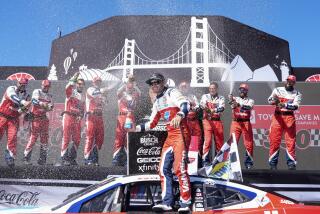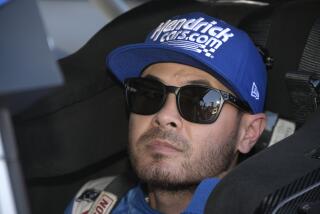Off-Track Fretting
- Share via
When Nextel Cup races endthese days, attention turns as much to the garage area as to victory lane.
There’s a good chance that drivers who collided during the race are exchanging accusations there and, sometimes, shoves -- as the television cameras roll.
NASCAR fans have seen it over and over again this year and in April, a wreck involving Greg Biffle and Kurt Busch had their girlfriends barking at each other before a national TV audience.
There’s nothing new about drivers “trading paint” in NASCAR, but their sparring, verbal or otherwise, seems to be escalating in step with stock car racing’s popularity.
NASCAR officials have penalized several drivers for aggressive actions this year. A newspaper columnist recently contended that the “road rage” has to stop before a driver gets seriously hurt. And reporters are continually asking the drivers if the finger pointing and blame game have grown worse than ever.
Hardly, many drivers say.
“Thirty years ago, they would have been actually fighting,” said veteran Jeff Burton, who drives the No. 31 Chevrolet for Richard Childress Racing. The disputes only seem more commonplace because so many more people, and TV cameras, are watching it, he said.
Dale Earnhardt Jr. agreed. In the 1970s and ‘80s, when Earnhardt’s late father was a top driver, “every week somebody was bumping, banging, carrying on, wrecking,” he said. “Back then, it was part of the game and you had guys running into each other every week.
“But the sport wasn’t under a microscope like it is now. Nowadays, guys won’t run over each other as quickly because they know the backlash is going to be tremendous from the media and the fans, and NASCAR is quite a bit more strict with its policies.”
That said, there have been plenty of incidents this year. Among them:
* After complaining about aggressive driving by younger drivers, reigning Nextel Cup champion Tony Stewart appeared to intentionally slam into Matt Kenseth’s Ford at the season-opening Daytona 500 in February, sending Kenseth sliding across the infield grass at nearly 200 mph and then into a wall. NASCAR penalized Stewart, and Kenseth retaliated by bumping Stewart’s Chevrolet in pit lane.
* In March, Kenseth tangled with Jeff Gordon in Bristol, Tenn., and after the race, an angry Gordon walked over and shoved Kenseth. Gordon was fined $10,000 by NASCAR.
* After Kyle Busch and Casey Mears had collided at the Phoenix race in April, Busch drove over and bumped Mears in retaliation -- during a red-flag period, when cars are supposed to stop. Busch was penalized.
* Gordon, in apparent retaliation for the Bristol race, spun out Kenseth with only four laps left at Chicagoland Speedway on July 9.
* Tempers flared again at Pocono Raceway in Pennsylvania on July 23 when Stewart tangled with Clint Bowyer’s Chevy, a wreck that also collected Carl Edwards’ Ford.
The normally affable Edwards called Stewart “a jerk” and added: “If it weren’t for the respect of the sport and the people watching, and his team, he’d be out there bleeding right now.”
Many racing observers peg the start of NASCAR’s surge in popularity to a day in 1979 when scrapping drivers nearly did bleed.
At the Daytona 500 that year -- the first to be nationally televised from start to finish -- Cale Yarborough and Donnie Allison crashed on the last lap. After their mangled cars came to rest, Yarborough, Allison and Allison’s older brother Bobby, who had stopped at the wreckage, began throwing punches. All on live TV.
Today, most of the fighting is verbal, and in most cases the drivers apologize within days. The drivers know that their sponsors, who provide millions of dollars a year in team support, aren’t crazy about negative publicity.
But the sponsors also want winners, and the pressure on drivers to finish well each week is a key reason why the outbursts seem to be increasing.
“You have all the pressure we have today from sponsors, from the media, from fans and it’s more intense, which, by the way, is why people watch it,” Burton said. “When things happen, it’s in your face a lot more than before.”
The blunt Stewart also has repeatedly complained that younger drivers today don’t have the patience or respect on the track that would keep them from getting into unnecessary wrecks -- and heated post-race arguments.
“You can’t blame them; they’re 19-, 20-, 21-year-old drivers that want to go out and they got cars and talent that can win them races,” said Stewart, 35. But they “don’t realize what happens in the first hundred miles, or first laps of the race, really doesn’t mean anything.”
Yet Stewart himself has come under criticism for dispensing his own justice on the track.
Stewart disputes that, but said, “You can sit and talk to them all day long, but sometimes it takes more than that once in a while.”
Another veteran, Mark Martin, is considered perhaps the cleanest driver in the Cup series, and he’s concerned that the current style of driving by others -- even if it’s less abusive than it was 20 or 30 years ago -- is still too rough.
“I’ve always tried to race people the way I wanted to be raced,” Martin, 47, said recently. “I never wanted to be robbed, and so never wanted to rob anyone.
“I believe I’ve raced with great ferocity,” he said, but added, “There’s not a lot of room” today for his style of giving rival drivers a little wiggle room. “That era is pretty much going by the wayside.”
Kenseth said the pushing and shoving on the track, and any driver’s deliberate or retaliatory moves, shouldn’t be taken lightly, for safety reasons. The Cup series hasn’t had a fatality since Dale Earnhardt’s death on the last lap of the Daytona 500 in 2001.
“Just because the sport’s had a pretty good safety record the last few years, I don’t think we should ever take that for granted and put anybody in harm’s way on purpose, that’s for sure,” Kenseth said.
More to Read
Go beyond the scoreboard
Get the latest on L.A.'s teams in the daily Sports Report newsletter.
You may occasionally receive promotional content from the Los Angeles Times.










